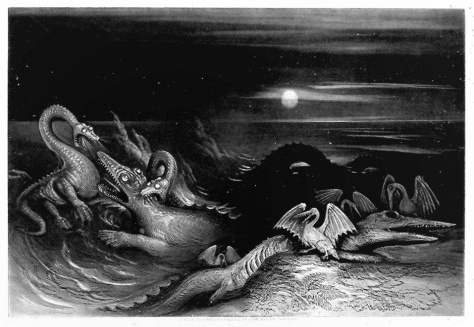
When prehistoric sea reptiles were first scientifically described, it was difficult for people of the time to conceive of these creatures the way they would a modern animal. It’s no coincidence that some of the earliest palaeoartists, like John Martin, were primarily known for apocalyptic Biblical illustrations – ancient animals seemed less like “real” animals, and more like the monsters of myth and scripture. Humanity has a habit of creating monsters like this.
Once upon a time, a monster dwelt in a river. It was a great and terrible beast: its broad flanks were black and smooth, like an ancient bull seal, large enough to rival even the mighty Stoorworm of Orkney. Yet despite its near five hundred feet of length, it was a silent swimmer, almost as elusive as the creature of Loch Ness – were it not necessary to breach the surface on occasion, one might not even know it existed. But its true danger lay not in brute strength, but the awful fire in its belly: within the beast lay the power to unleash an inferno miles wide, a poison with no cure or antidote that lingered for decades wherever it touched, and a light that blinds all who witness it from leagues away. This monster was not natural – it was created by the hand of man, and creatures of its ilk wrought untold horror in lands on the other side of the world.
The emperor of a faraway realm controlled this monster, but he did not want the beast to live near his subjects, or risk despoiling his hunting grounds and scenic landscapes. So he brought the beast here, closer to his enemy’s empire, to this land. Our country did not yet have a leader to defend our interests, so the lord of our southern neighbours – who had long asserted their dominion over our lands under the guise of an “equal union” – parleyed on the matter of the monster. The lord wanted to imprison the monster in a great loch where few of our people lived, but the emperor insisted on keeping the monster closest to the most populated city of our realm – so that the monster’s guards could easily take leave and enjoy our hospitality. Despite the love our neighbour’s lord felt for our land’s grouse moors and castles – if not our people – he felt he had no choice but to allow the emperor to place the beast in a holy loch.
The monster dwelt there for a generation. The guards brought the beast out in chains to patrol the sea round the land, to impress and intimidate the rival empire to the east, and deter any would-be invaders to the realm. And all the time, the creature belched its poisonous fumes, corrosive bile dripping from its maw, into our pure air and crystal waters. The beast which was claimed to protect the land was destroying it. Some of the people rose up against it, seeking to drive the monster from our waters, but the emperor’s men were strong, and the lords of our southern neighbours did not want to risk his wrath. So the beast remained, roaring and rending the land, while the people waited anxiously for the horns which heralded the coming of its nemesis – and their oblivion.
Scotland is a land of monsters. We all know the mythic beast that dwells in Loch Ness – but Nessie is but one of the many creatures purported to lurk in the depths of Scotland’s waters. In the misty summit of Ben MacDhui, a being known as Am Fear Liath Mòr reigns supreme, a liminal creature guarding the gateway between worlds. Banshees, Bean Nighe, Bodachs, Bogles, Boobries, Each Uisge, Kelpies, Red Caps, the Nuckelavee. In modern times, humanity doesn’t have to imagine monsters lurking in the lochs, the moors, the shadows. Humanity creates monsters of our own.
I was born in Greenock, and currently reside in its neighbour, Gourock. I’ve already talked about living in the shadow of a monster during my childhood. This week, it all came rushing back. The House of Commons held a debate. The motion was whether MPs agreed with the following statement: That this House believes that Trident should not be renewed. Trident, of course, was one of the fixtures of the independence debate. Most New Labour MPs – those that actually opposed nuclear weapons, at least – said that they want total disarmament of the UK rather than “just” Scotland, arguing that if we just stuck around, we could work together to rid the UK of nuclear weapons entirely.
Well. Here was their chance.
Conservatives: 254+2 tell voted No, 1 voted Aye. (84.8% turnout)
New Labour: 102 voted No, 19 voted Aye. (46.9% turnout)
SNP: 5+1 tell voted Aye.
Neoliberal Democrats: 5 voted Aye, 1 voted No. (10.5% turnout)
DUP: 5 voted No. (62.5% turnout)
Plaid Cymru: 2+1 tell voted Aye.
SDLP: 2 voted Aye. (66.7% turnout)
Alliance: 1 voted Aye.
Green: 1 voted Aye.
Respect: 1 voted Aye.
UKIP: 1 voted No. (50% turnout)
Independents: 1 voted No.Total: 37 Ayes, 364 No. (62.9% turnout)
(Those without percentages in brackets had 100% turnout)
Iain McKenzie, MP for Inverclyde, my home constituency, voted against the motion. Alan Reid, MP for Argyll and Bute – the constituency in which Faslane itself is based – voted against the motion. Of the 28 Scottish New Labour MPs who turned up for the vote, only 6 voted for the motion. The rest? They voted to make a new monster, to spend billions feeding it, while people starve and freeze and die. Such is humanity’s way: when there are no monsters to threaten us, we make our own.
In 1952, humanity created the Angel of Death. An unseasonably cold winter and unusual weather conditions gathered smog around the city of London. The people were not concerned, used as they were to pea soupers. They carried on as usual, save to burn more coal in their fires to combat the chill. It was only in the following weeks that the Creeping Death struck: hundreds of tonnes of carbon dioxide, hydrochloric acid, fluorine and sulphur dioxide swirled in the air every day, smothering and suffocating the people.
The Creeping Death was thick and deadly. Public transport had to be cancelled, the density so high it rendered the city practically blind. By the time it was over, 4,000 people had died – though recent research puts the death toll three times that number – and 25,000 were incapacitated.
In 1971, humanity opened a doorway to Hell. Soviet engineers in Turkmenistan thought they discovered a great oil field site, and started drilling operations. They built a drilling rig and camp. They drilled and drilled for the precious fuel, reckless in their desire for wealth and resources, unheeding the warning signs that they may be digging too deep.
Then one day, the ground itself swallowed the entire site. Brick, mortar, steel, all chewed up by the vengeful earth. It was a small miracle that no lives were lost in the chaos – yet. Fearful that poisonous gas could escape from the newly-created cavern, the Soviets believed it would be safer to burn the gas off. So they set the gas alight, feeding it with fire, hoping to satiate the fire-demon’s hunger. They hoped it would burn out in a few weeks. It still burns after over forty years.
In April of 1986, humanity created Medusa. She was born in Chernobyl, in the aftermath of the catastrophe which spewed radioactive material across Europe – even Scotland was affected. She was birthed by the meltdown itself: when the molten uranium dioxide fuel cascaded from the reactor core, it melted through the concrete and steel and every protective layer. Two tons of black lava poured down to the bottom of the shaft, where it piled into a mound. This mound is the Elephant’s Foot – and like Medusa, if you looked directly upon it, you would die. The sheer bombardment of radiation was so powerful that photographs had to be taken indirectly – like Perseus using his polished shield, scientists remotely positioned a mirror around the corridor, and photographed the reflection. Even remote-controlled cameras were destroyed by the gaze of the Elephant’s Foot.
What does the gaze do to you? When it first formed, it was deadly. After thirty seconds, you become dizzy and fatigued, even for a week afterwards. Two minutes brings cell haemorrhage. After four minutes, all control over bodily functions is lost and fever breaks out. Five minutes, and you will die within two days. Ten years later, and even with only a tenth of its original power, an hour of exposure was still lethal. And even after thirty years, the Elephant’s Foot is still melting through the foundation of Chernobyl. If it ever touches groundwater, it could trigger another explosion, or worse, leak radiation outside the steel sarcophagus which currently contains it. The Elephant’s Foot will remain radioactive for a hundred years.
The Monster of Faslane has not claimed any lives yet. But we are living in the graces of the fates. We’ve been fortunate that none of the literally hundreds of leaks, safety lapses, fires, and unspecified “shortfalls in the safe management of nuclear weapons” have resulted in disaster for the people of Scotland. But how much longer are we going to tempt fate – especially when the number of incidents have only risen? How much longer are we going to let the worthless drones of the New Labour party claim to support disarmament one day, only to explicitly vote against disarmament the next – sometimes even at the same time?
For decades, the people of the land lived in mortal terror of monsters – be they creatures from a land far away, or the horrors that lurked in their own home. But the nemesis never came. More people were killed in taming the monster than by the predations of foreign horrors; more devastation caused to the land by its supposed protector than any invader. This great power play between empires all came to naught – but lives were still lost, livelihoods still ruined, minds still traumatised.
It is two decades since the Holy Loch Monster left – not through fire, but through peace. The eastern empire fell, and with its collapse, the new western emperor decided that the monster was no longer needed. But the southern lord thought otherwise. So now, a great black beast with a fire even more terrible than the first glides silently through the rivers and firths of the West Coast, the last of its kind. And if the people choose to continue allowing the southern lords to determine their destiny, another monster will take its place, a nightmare more monstrous even than this.
And another.
And another…
But not all monsters take physical form: not all are great ironclad horrors spewing death and misery in their wake. Sometimes people do not create monsters – sometimes they become the monster. Are we going to have to fight monsters… with monsters?
It isn’t so strange an idea. After all, the more extreme elements of New Labour in Scotland – like its new communications director, its new chief strategist, its new head of strategy and policy, and so forth – have called independence supporters every name under the sun. It’s almost every other day independence supporters are likened to decidedly human monsters. It’s almost as if they want independence supporters to be the monsters they keep saying we are – that they want us to be racist, xenophobic, fascist, communist, violent, evil creatures. Who knows? Maybe we are monsters, for wanting to “destroy” their “country,” the UK.
But if we’re monsters simply for wanting to take control of our own affairs, what does that make them?
There were many reasons many of the people chose to allow the southern lords to rule over their land. The minstrels, merchants, criers and knights all said that rule from the southern lords was better compared to the unknown of self-determination. The southern lords whispered lies into the people’s ear, promises to bestow riches and wonders upon the people if they would only subject themselves to southern rule, prostrate themselves, swear fealty to them. The minstrels of the land were ever-eager to bring word of these new wonders, spinning their deception with desperate glee. And all the while, it was the patriots who were painted as The Enemy – separatists, iconoclasts, traitors.
None were more instrumental in turning the people against their own destiny than they who proclaimed themselves their greatest protectors – they who called themselves Labourers. They started as honest and true advocates for the working people, the lowest in society, they who needed the most help. But they were corrupted from within, their old ideals usurped by snakes and foxes in their midst, until they were no better than the southern lords they still feigned to oppose. All who opposed them were deemed traitors to the Labourers, little more than Gnats – an insult apportioned to Nationalists, their great rivals in the battle for the land’s soul. So wretched and ruinous was their hatred of the Gnats, they would rather ally with the southern lords than consider working with their fellow countrymen.
But after the plebiscite, the Labourers did not realise it was not the end they sought to The Question of the Land. This would not kill the Nationals stone dead. Far from it: in the days following the plebiscite, the people flocked to the Nationals, swelling its ranks to an enormous degree. Far from destroying nationalism, defeat had only invigorated their desire for self-determination. And now the people knew of the Labourers’ betrayal – and the new, greater Nationals, larger and stronger and filled with more terrible wrath than ever before, would ensure that it would never be forgotten.
When the Labourers signed the blood-oath with the Southern Lords, they did not predict that striking down the Nationals would not kill them – far less that they would arise more powerful. In their attempt to slay the monster, they only made it greater. And they cannot survive another battle.

“What though the Moor the Basilisk hath slain, and pinned him lifeless to the sandy plain, up through the spear the subtle venom flies, the hand imbibes it, and the victor dies.” – Lucan

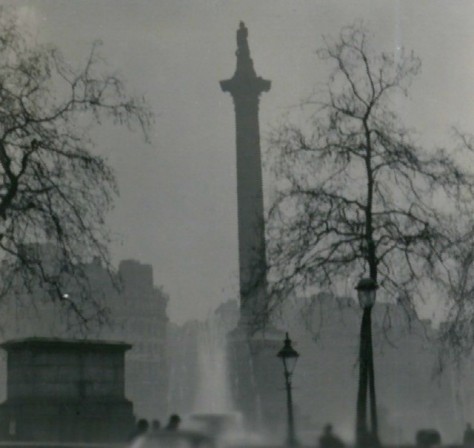
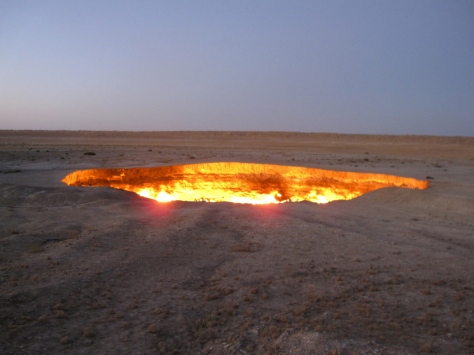
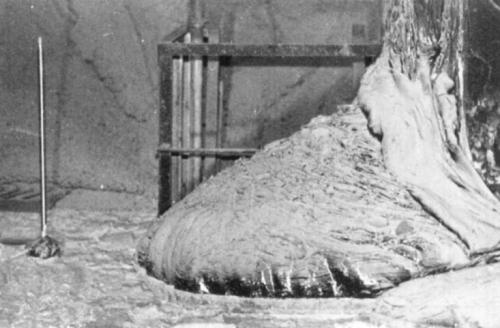
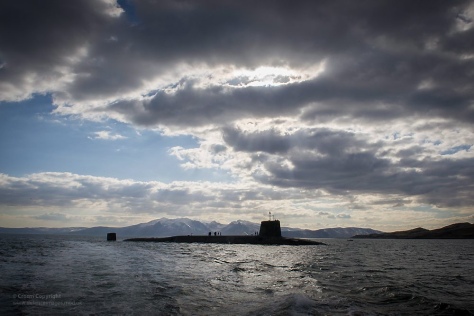
Brilliant. I’d love to see this in the next version of the Wee Blue Book as a persuasive complement to the host of self defeating quotes and facts about Labour in Scotland that ought to be republished before the GE in May.
A brilliant piece of writing.
A very good article. Now if you could also do it in comic-book format…(or graphic art, or narrative art, I’m not fussy!)
[…] post. The Greenland-Iceland-UK Gap could be considered a strait of sorts, with the horrors being man-made rather than mythological. We even have our own Charybdis – guess we know what our Scyllas […]
[…] a post-nuclear apocalyptic world in 1986’s Time-Slip, where Scotland is (as the moment, incredibly optimistically) one of the few surviving nations. Paul Johnson’s Quint Darymple series is set […]
[…] spoken before on the monsters lurking in the the river I live beside: nuclear-powered submarines which bear nuclear missiles many […]
[…] Chinese-Japanese xenophobia, and Israeli-Palestinian violence, to say nothing of nuclear disarmament and pacifism. For some reason, peace seems be […]
[…] regular readers of the Wilderness will know, this is a subject deeply personal to me. So, well, I could hardly refuse, could […]